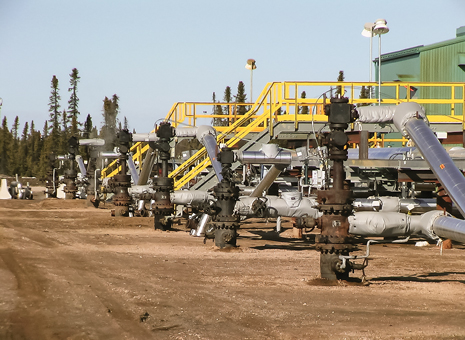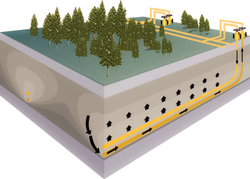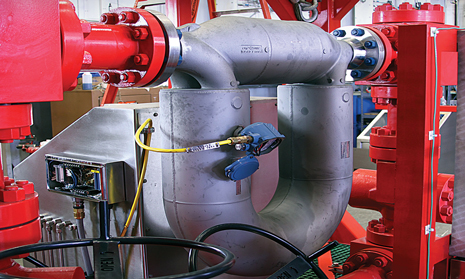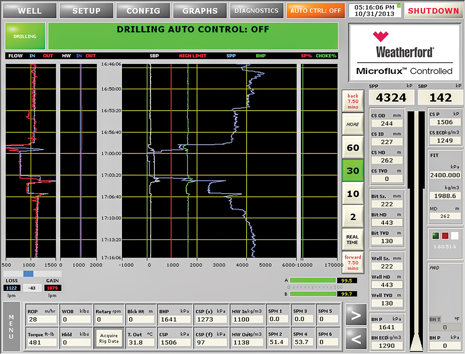 |
| Steam-assisted gravity drainage (SAGD) technology is used in underground wells to inject steam into the oil sands deposits and collect the bitumen released by the heat (photo courtesy of Suncor Energy Inc.). |
|
By some industry estimates, up to 80% of Canada’s oil sands reserves are too deep to be mined, leaving in-situ production processes, such as steam-assisted gravity drainage (SAGD), as the only viable recovery options. The typical configuration for a SAGD operation involves drilling a pair of parallel horizontal wells, one slightly above the other. The upper well is the steam injector, in which pressurized steam is injected downhole to heat bitumen surrounding the wellbore, Fig. 1. This lowers the viscosity of the heavy oil, allowing it to flow via gravity to the lower well (the producer) and then be carried to surface.
 |
| Fig. 1. In SAGD, a pair of parallel horizontal wells is drilled. The well on top is used for steam injection and the lower well for oil recovery (image courtesy of Suncor Energy Inc.). |
|
While an increasingly popular oil-sands recovery method, SAGD is not without its problems. Drilling issues in the form of low reservoir pressure, tight well spacing, highly pressurized steam injection, cap rock integrity and tight drilling windows are among some of the challenges facing SAGD operators today. Without a means of successfully addressing these challenges while minimizing any environmental impacts, an operator may be forced to shut in a well and leave substantial volumes of technically recoverable reserves in the reservoir.
BRINGING A WELL BACK
This was the challenge facing Suncor Energy as it decided how to best revitalize production from a well in Dover field, located in the Athabasca oil sands area approximately 45 km northwest of Fort McMurray in Alberta. The well had been shut-in following multiple failures in the liner that resulted in excessive sand production.
To repair the well and resume production, Suncor decided to re-drill the horizontal section and install a new slotted liner. Re-drilling a producer well in a shallow, over-pressured and hot reservoir would be a first for Suncor in this area, and would present some unique challenges related to managing wellbore pressures.
First, the formation pore pressure was estimated to be roughly 199 psi, and fracture pressure was estimated at approximately 345 psi, based on offset and known pressure information in the area. This resulted in a tight drilling window of approximately 145 psi, leaving very little room for misinterpreting wellbore volumes, equivalent circulating density (ECD) or bottomhole pressure (BHP).
Drilling with such a narrow pore pressure-to-fracture pressure window in a mature steam chamber, while having adjacent steam injectors and producers near the well in question, can create BHP control issues. And, because the field has been running on steam injection for more than six years, the steam chambers from adjacent wells have commingled to essentially create one large, coalesced steam chamber for all of the producing wells in the area.
Significant fluctuations in BHP can lead to a weakening of the caprock and compromise wellbore stability. If the BHP, during drilling, should exceed the fracture pressure of the caprock, there is a risk of losing caprock integrity, and having oil and steam propagate to the formations above, into the ground water, or to the surface. The environmental impacts would be severe, and, with no current way to repair the caprock, that area and all surrounding wells would have to be shut-in, effectively sterilizing the production area.
Hole stability issues may also arise from the reservoir rock’s exposure to high temperatures from steam injection over time. The temperature of the formation increases the temperature of the circulating fluid, which could soften the bitumen, resulting in hole-stability issues, washout, and increasing amounts of cuttings volume.
BRINGING MPD TO SAGD
The narrow drilling window, coupled with reservoir temperatures expected to exceed 320°F, left Suncor with limited drilling options. Drilling in an overbalanced state, with a weighted water-based mud (WBM), for example, would prove problematic in a situation, where mud circulation was interrupted resulting in the well temperature rising. The polymer in the mud would eventually break-down, causing the weighting material to fall out of solution and reducing the density of the fluid to near-water gradient. An underbalanced situation would, therefore, result with the well flowing into the wellbore.
The only other option, and one that had never been attempted in a SAGD well, was to deploy managed pressure drilling (MPD) techniques to maintain the downhole pressure values required while drilling the well, Fig. 2. The advanced MPD techniques employed by Weatherford’s Microflux Control System (MFCS) were proposed, along with a WBM of sufficient weight to drill the well and maintain the necessary BHP to keep the wellbore in a slightly overbalanced state. The system’s ability to detect micro influxes and losses while drilling, combined with an automated control system, would allow Suncor to meet its well objectives. These include:
- Safely reducing the time and cost required to re-enter the production section from 880 ft to 3,232 ft, MD.
- Drill the well while holding a constant BHP in both dynamic and static conditions.
- Eliminate potential losses and prevent any steam influxes, which could result in a well control event.
- Improve drilling performance and minimize reservoir damage by avoiding the use of weighted mud systems that would cause formation damage.
 |
| Fig. 2. MPD provides additional value for SAGD wells by increasing safety to the drilling process and the environment by maintaining bottomhole properties, as required, and as constant as possible. |
|
Suncor and Weatherford worked together to develop a drilling strategy and all required parameters, which included reviewing a detailed risk mitigation planning process to understand the perceived risks while drilling, and how the MPD system should be designed to minimize these risks. Detailed work went into modeling various mud weights, pump rates, surface friction pressures (based on the MPD surface equipment), and the required surface back pressure (SBP) while drilling and during connections.
The modeled data suggested that the well should be drilled at a bottomhole circulating pressure (BHCP) of roughly 239 psi, using an unweighted WBM system, with a density of 8.92 ppg. This would result in BHCP approximately 43.5 psi above the estimated formation pressure, thus helping to minimize reservoir damage and to control the BHCP within the tight drilling window. Other objectives included:
- Drill the horizontal section using a single-phase MPD technique, with an 8.92 WBM, while setting the BHP ECD to 10.43 ppg.
- Gradually adjust drilling fluid injection rates and the choke settings, as downhole conditions dictate, to maintain a constant bottomhole (BH) ECD.
- Hold SBP during connections to maintain the set BH ECD.
- Once TD has been reached, pull out of the hole and run the slotted liner.
BRINGING THE SYSTEM ONLINE
The MPD equipment was rigged in, consisting of Weatherford’s specialized surface equipment, which included a rotating control device (RCD), MFCS with two chokes, a Coriolis mass flowmeter (Fig. 3), auxiliary pump, degasser and a flare stack.
 |
| Fig. 3. A key MPD component, the Coriolis mass flowmeter, provides real-time data for volumetric flow, fluid density and return mud temperature. |
|
The control system was intended to minimize any influx into the wellbore, by using a proprietary hydraulics model in combination with a Coriolis mass flowmeter, to continuously measure the flowrate, volume, fluid surface temperature and drilling mud density, Fig. 4. The chokes would be activated automatically, whenever the flow parameters changed beyond pre-set limits, thus helping to minimize the threat of a kick or an overbalanced condition, leading to fracturing of the caprock.
 |
| Fig. 4. The Microflux Control System (MFCS) is able to detect and control micro influxes and losses while drilling, enhancing the ability to make a successful connection, while maintaining constant bottomhole pressure (CBHP). |
|
The well fluid travels through the outlet of the RCD, where it can either be directed to the shaker (conventional drilling) or the drill-out line (MPD). Drilling fluid also can be directed after the MFCS, either back to the shaker or through the degasser, if nuisance gas is present. Any minimal gas influx within the wellbore would be degassed by the surface degasser, gas flared, and the drilling fluid and solids returned back to the drilling rig’s fluid management system.
As a contingency to ensure against exceeding the formation fracture pressure while drilling, Suncor installed a pressure gauge in the injector well at the halfway point (at 1,300 ft in the 2,600-ft long lateral). This gave them the ability to monitor, in real time, if pressures were beginning to approach or exceed the maximum allowable downhole operating pressure and make any necessary corrections before caprock integrity was compromised.
RESULTS
The thorough upfront planning between Suncor and Weatherford was instrumental to a successful MPD operation in this SAGD well. A total of 2,350 ft was safely drilled for the re-entry production section of this SAGD well in 19.25 bit hr, with a 8.92-ppg polymer WBM, resulting in an average ROP of 122 ft/hr.
Through the use of the MFCS, Weatherford maintained a constant BHP of 239 psi during the entire drilling operation. The MFCS successfully calculated and adjusted accurate ECD values throughout the drilling profile of the entire main hole section, and the chokes were adjusted on-the-fly, as the injection rates changed to help optimize the drilling operation. Friction pressure was replaced with SBP when rig pumps were turned off, to prevent an underbalanced condition from occurring.
Caprock fracture pressure was not reached or exceeded at any time during drilling operations. Consequently, no damage to the formation was observed. With the MPD system run in an auto-control mode, it had the ability to detect micro influxes and losses while drilling and during connections. A virtual pressure relief valve (PRV) was built into the system, and ensured that the pressures were maintained below the expected fracture pressure at all times during the entire drilling operation. Should the pressure have reached the set high limit within the system, the chokes would have been opened by the system to minimize any risk to the formation.
Minimal fluid losses were observed throughout the entire well, with a total loss volume calculated to be 272 ft3 of WBM. Since the MFCS accurately calculates flow in, and the mass-balance flowmeter measures flow out within tolerance of gallons, it is assumed that the volume of fluid lost was to the formation and not on surface.
The entire drilling operation was conducted with no injuries reported from any of the parties involved, thanks in part to thorough pre-job training to ensure that all in-field parties understood the safe running of the MPD techniques and equipment. Weatherford personnel participated in all safety meetings, job safety analyses, assessments, stop card programs, and operational engineering meetings throughout the project.
Once TD was reached, the well was displaced to 11.93 ppg brine kill mud. The displacement began by pumping the kill mud down at a rate of 35 ft3/min. Once the fluid hit the bit, the pump rate was reduced to 28 ft3/min and maintained throughout the displacement. The bottomhole ECD was maintained at 10.43 ppg. Once the circulating pressure increased above desired levels, both chokes were opened, and flow was directed to the gut line to reduce to friction pressure caused by the surface line restrictions. The BHCP remained fairly constant within 239 psi during the entire process.
Suncor was pleased with the outcome of the entire MPD program, which allowed the slotted liner to be installed successfully and get production back online. The program achieved this without any damage to the formation, contamination of neighboring wells and without exceeding formation fracture pressure. Such an event may exceed the caprock integrity, and risk having a steam and oil release to the surface.
Since being put back on production in late 2013, the well has produced at a rate higher than expected. Suncor is now in the process of identifying other wells in the field that are suitable candidates for this MPD method of well construction. 
|







